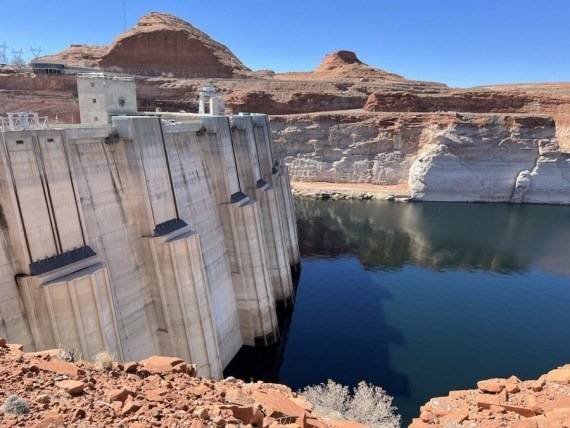Glen Canyon Dam is the second highest concrete arch dam in the country, behind only Hoover Dam that holds Lake Mead, according to USBR, calling it a “bank account of water that is drawn on in times of drought”….reports Asian Lite News
As record low levels of water threaten supplies for some 40 million Americans, the US government has announced unprecedented measures to boost water levels at Lake Powell, an artificial reservoir on the Colorado River and the second largest in the country.
According to a statement released by the US Bureau of Reclamation (USBR), authorities would delay the release of water from the severely depleted Lake Powell, which could keep 480,000 acre-feet (592,070,400 cubic meters) water in the reservoir, and release an additional 500,000 acre-feet (616,740,000 cubic meters) of water from the Flaming Gorge Reservoir upstream 450 miles away into Lake Powell.
The Glen Canyon Dam, in northern Arizona, built in 1963 to hold Lake Powell waters, is one of two huge Colorado River reservoirs that supply water to Nevada, Arizona, Southern California, and several other states.
It also supplies water to the downriver Lake Mead, the largest artificial reservoir in the US.
The two reservoirs are both “at the lowest level since Hoover Dam and Glen Dam were constructed”, the USBR said.
Glen Canyon Dam is the second highest concrete arch dam in the country, behind only Hoover Dam that holds Lake Mead, according to USBR, calling it a “bank account of water that is drawn on in times of drought”.
As of Thursday, Lake Mead’s level is at 1,053.69 Feet MSL, 175.31 feet below full pool of 1,229.00 Feet MSL. And Lake Powell is at 3522.83 Feet MSL, 177.17 feet below full pool. If Lake Powell were to drop another 32 feet, the 1,320-megawatt plant would be unable to generate electricity.
“We have never taken this step before in the Colorado River Basin, but the conditions we see today and the potential risk we see on the horizon demand that we take prompt action,” Tanya Trujillo, an Interior Department assistant secretary, told the media.
The Department described the move as an “extraordinary act meant to stave off increased uncertainty in water and electricity supplies in the West” .
The decision will keep more water in Lake Powell that “currently holds less than one-quarter of the amount it held when filled after the dam was built in the 1960s”.
Last year, federal officials ordered the first-ever water cuts for the Colorado River Basin.
The western US region has experienced the driest period on record over the past two decades. Some experts say the term “drought” is inadequate because it suggests conditions will return to normal.

Leave a Reply